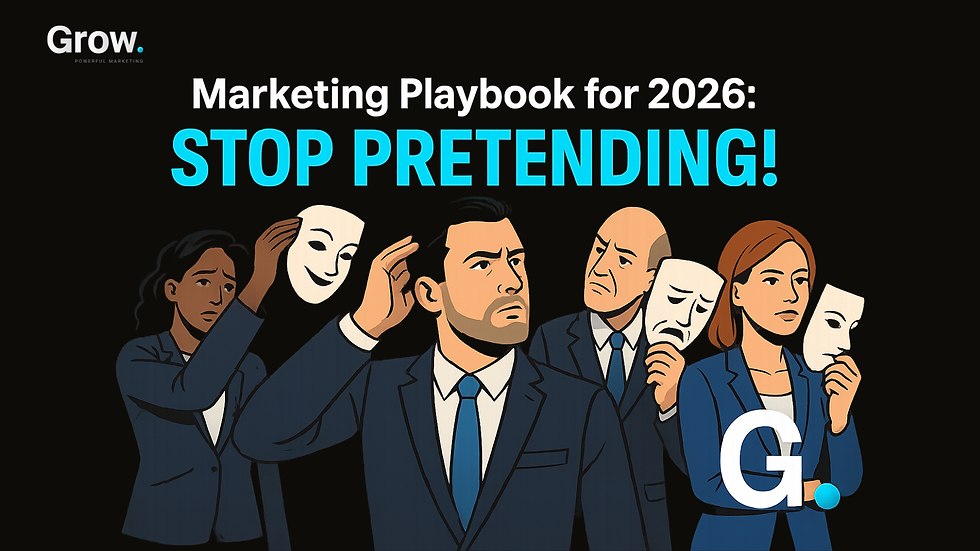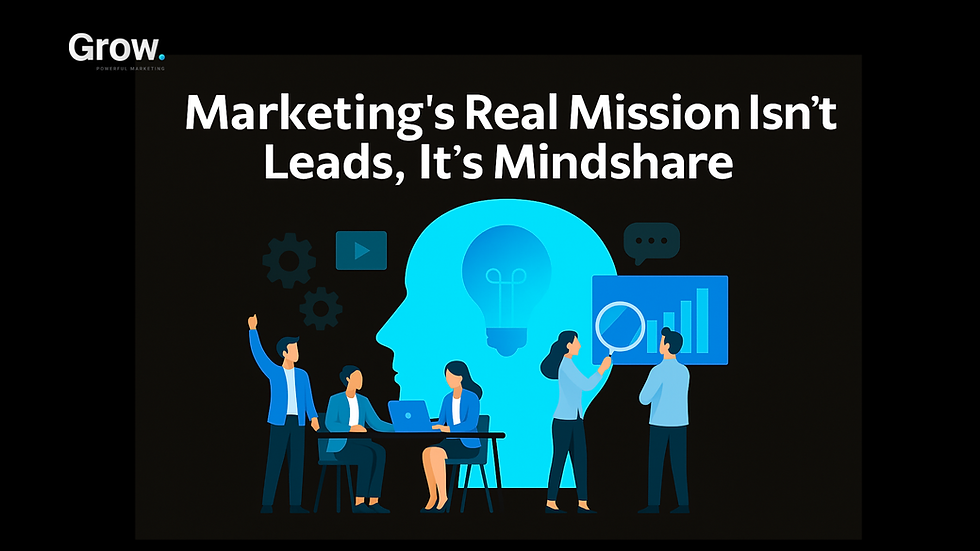CEO Growth Guide: Find Your Competitive Advantage as a Purpose-Driven Company
- anna3951
- Mar 14, 2023
- 5 min read
Written by Brett Schklar & Gary Van Prooyen

2023 has been chaotic.
Things are tightening in the tech world, and competitive advantage is more critical than ever.
Why?
Because while the ‘pie’ isn’t getting any bigger right now, competition for more of that pie is heating up.
They want your customers and are investing to do so.
Fortunately, there are ways to stop them from doing that.
What’s Changed?
Something that’s changed over the past five to ten years is that success in the tech industry was previously dictated by scale. It meant the big players participated in the innovative marketing channel opportunities.
But over the past 12 months, this has significantly changed.
The battle cry of “Grow at any cost” is a ghost of growth-phase past.
Companies beginning their journey to become marketing-driven have many opportunities to create a compelling mix. Some small businesses might not be ready to invest in a formal CRM, but it’s not stopping them from doing the activities available in this software.
Social media has made it easier to get their message out there. It’s not just about products and promotions. They post content on who they are and what they stand for. These businesses even use it to attract talent. Many companies also understand the power of inbound by using SEO.
These companies are no longer saying that they don’t have the budget for these activities. They are creating a marketing mix of inbound, outbound, social, and organic SEO. It’s leveling the playing field and allowing them to compete.
What is the Unique Reason Why Your Company Exists?
When moving into an omnichannel marketing perspective, it becomes even more critical to understand your company's unique role today.
It might sound basic. But you would be surprised how many companies struggle to answer this question. But it’s imperative.
It’s much more than a positioning statement or a brand campaign.
It’s the core DNA of what makes you get up every day and drives you to win.
Defining Purpose
Purpose is authentic.
It’s driven by who you are as a company and your understanding of what the world seeks from you.
If you can find the intersection of what the world needs, what you do better than anyone else in the marketplace, and the difference you’re trying to make, you’ve captured lightning in a bottle.
It drives your business strategy and understanding of who you serve and what they’re looking for. It also determines the difference you’re making to the world.
If you can find where those intersect, it will drive your company, employee motivation, and competitive advantage.
How to Define Your Purpose
It starts by understanding who you are as a company.
Most businesses don’t stop and ask who they are and who they are not.
Defining your purpose doesn’t have to be a complex process. It’s a discovery exercise with people across different organizational roles, tenures, and ranks. It shouldn’t just involve the C-suite.
The process also involves an honest conversation with clients. You should ask them what it is about your company that attracted them and why they keep coming back.
Complete some structured exercises to determine what sets your company apart and whether they are ownable. You don’t want something that every other business can claim is its purpose too.
That end statement should state who you work for. It’s unique regarding what you’re doing, why you’re doing it, and who you serve.
Who Has Defined Their Purpose Well?
Google is just one of many examples.
A couple of years ago, the company set out to define its purpose. They concluded that “we exist to organize the world’s information and make it universally accessible and useful.”
Compare that to the usual mission statement on a company wall.
Google’s statement determines if it’s for them, whether they belong there or not, whether they should pursue it or not, and is it helping them take information and make it more accessible and valuable.
Uber is another excellent example. Its statement is, “we ignite opportunity by setting the world in motion.” There is so much built into that sentence. It’s about providing opportunities for their drivers and creating more robust cities. It’s about getting people to where they need to be.
Purpose Doesn’t Change
Purpose, barring some unexpected structural change, lasts for the long haul.
It’s not something you dust off every two years so that you can come up with something newer or sexier. This describes who you are, what you set out to do every day, and how you can succeed in making a difference.
That doesn’t change overnight.
You might have new acquisitions, people, and leadership, but your purpose acts like a north star and doesn’t change with a company for a long time, if ever.
Responding to the Skeptics
Some people within the company won’t believe defining a purpose will change a business's momentum, growth, or success. It’s just a marketing exercise.
But it’s worth taking another look.
In the past five to seven years, there has been a lot of quantitative research about the difference between companies with formal mission statements and those that get laser-focused on becoming purpose-driven companies.
Jim Collins’ Built to Last includes a lot of this information. Companies with clearly defined purposes and values outperform the general market by 16 to 1 and their peer group by 6 to 1.
Purpose gives leaders a platform to speak from. It also helps with investment decisions and other choices you need to make. You have a compass point where you can ask if it’s aligned with who you are and what you are as a company.
It’s also essential for staff attraction and retention. Purpose is a millennial magnet. There is a generation that wants something beyond their payslip and wants to do something important for the world. If you don’t have that, you might lose incredible talent.
How to Make Purpose More Than Just a Plaque on the Wall
The easy part is defining the purpose. The hard part is infusing it into everything that you do.
You need to look for ways it can interweave into your company culture. For example, it could be in how you attract and retain talent. When recruiting new team members, you should discuss it in your job posts. Another example is how you integrate it into employee recognition and annual reviews.
You need to think about what you can do so that it doesn’t fall off the map.
Don’t forget the basics: Marketing Needs to Take a Number
Some people in marketing are talented and understand that they play an influence but don’t want to be pinned down to a quantifiable metric.
But in today’s business world, you can’t stand for what you do as a marketer without putting your money where your mouth is. You need to step up and own a number. That means developing a plan, working it, and creating contingencies until you hit it.
If marketing wants to be loved by the sales department, they need to go into a room and ask them what the number is so they can sign up for it.
Join us wherever you learn and grow
Discover a wealth of empowering insights and tips like these from GROW Powerful through our Grow Up with GROW podcast, which can be accessed on all major platforms. Keep up to date with our latest updates and exclusive content by subscribing to our LinkedIn newsletter, and become part of the GROW Powerful community to unleash your full potential!




Comments